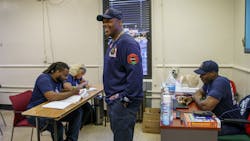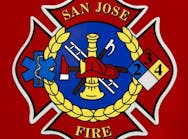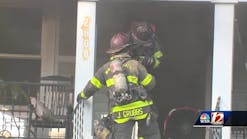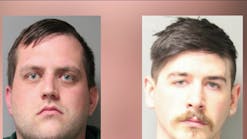Chicago FD Struggles to Reflect the City’s Demographics in their Ranks.
By William Lee
Source Chicago Tribune (TNS)
Quention Curtis said he’s tired of talking about race and the Chicago Fire Department. It’s no secret that Black firefighters have lagged far behind their white counterparts for decades.
What the veteran fire lieutenant-emergency medical technician would like to focus on is how more training could increase the number of Black candidates applying for firefighting jobs, leading to more Black people in the ranks.
A clause in a collective bargaining agreement from the early 1980s requires the department to strive for as close to 45% minority representation as possible in all ranks. The department of nearly 4,800 uniformed members currently has 721 Black employees, which represents 15%. Of that number, 422 are firefighters, 35 of them women, according to department numbers the Tribune received in a records request. Hispanic representation is higher at 18%.
The department’s most common rank, firefighter-EMT, had 277 Black employees compared with 796 white and 283 Hispanic, according to a personnel report from the city’s office of public safety administration. On the paramedics side, the numbers are more stark. The department had 33 Black paramedics, compared with 257 white and 76 Hispanic.
The department’s command staff, including captains, lieutenants, engineers and battalion chiefs is also largely white and male.
“It is what it is. It’s an unspoken thing,” Curtis said recently at the Black Fire Brigade’s South Side firehouse on South Wabash Avenue, one of two it owns. “I tell people I don’t want to talk about racism — it was here before I got here; it’ll be here when I’m gone. Let’s talk about change. What are we going to do to change it?”
Raised in Cabrini-Green, Curtis runs the fire brigade, his own not-for-profit that trains young people and minorities in firefighting techniques so they can earn professional licenses. With this training, brigade graduates are better equipped to apply for paramedic and EMT jobs, or take the CFD entrance test when offered. The test was last given in 2014. Because of years of litigation and large applicant pools, tests have been offered infrequently.
In a city with a falling but still large Black population, encouraging more Black residents to join the ranks of the Fire Department has the potential to revitalize troubled neighborhoods, Curtis, 57, said.
Though three African Americans have led the Fire Department, including current Commissioner Annette Nance-Holt, the department’s first Black woman leader, the upper ranks are still mostly male and white.
Even with a recruitment push by Fire Department brass, the number of Black firefighters and paramedics has fallen to third behind Hispanics and whites of the same rank.
“I need diversity greatly in my entry ranks and up through,” Nance-Holt said during a budget hearing in October, according to Block Club Chicago. “Because the only way to get people to this position (is for them) to walk in the door. If we can’t get them in the door, we can’t make them engineers, lieutenants, captains … on up the ranks.”
Low numbers aren’t unique to Chicago; the federal government has investigated fire departments in New York, Baltimore, Philadelphia and Florida, according to published reports.
Last year, organizations representing Los Angeles’ Black and Latino firefighters called for a federal investigation into claims of rampant racial bias and ill treatment within the department, according to the Los Angeles Times.
Along with creating the culture, traditions and character of the modern urban fire department, experts and historians say an Irish chain of command maintained an insular social hierarchy that opposed any advancement of Black firefighters across the country.
The result has been an industry where white men make up about 80% of U.S. career firefighters, according to the Bureau of Labor Statistics.
In Chicago, veteran and retired Black firefighters are also fearful that an expected cascade of retirements by Black firefighters will further reduce the department’s numbers.
Curtis will hit his 35th year with CFD in December.
But he is convinced that programs steering young adults toward fire services with high salaries offers a path toward middle class living and could lead to welcome cash infusions in the city’s underserved neighborhoods.
The starting salary for a firefighter/EMT is about $63,000 a year, but salaries can quickly rise based on certifications and licenses.
Curtis said fewer Black firefighters in the department equals a missing stable income in neighborhoods that desperately need them. “What does that equate to? Crime. Bottom line.”
‘An opportunity to make a difference’
Carmelita Wiley-Earls has the deft touch of a velvet hammer, a mix that’s part grandmother, part drill sergeant. Her speaking voice is soft, but commanding, as one would expect of a woman who served as a deputy district chief, a fire marshal and the commander of the fire academy before her retirement last November.
She says her rough and tumble upbringing on the West Side prepared her for a CFD career that has included some unpleasant experiences and challenges by subordinates.
“I grew up with four brothers that didn’t like me so it was a perfect fit,” she said in a second-floor instruction room at the brigade’s Washington Park firehouse. “What I didn’t understand was that they were preparing me for this job. Isolation. Nonacceptance. Earning your way ... which is not a bad thing. Sometimes you need to be isolated to focus.”
Wiley-Earls uses the lessons of her 30-year career to help instruct and hopefully inspire the young men and women attending the fire brigade’s training course that has produced 460 graduates who earned a state paramedics license and are working for fire departments and ambulance companies. The graduates include 130 single mothers and 13 homeless people.
“The Black Fire Brigade prepares students that have never been exposed to this type of opportunity — and I’m going to keep talking about that word, because that’s all it is. It’s an opportunity to make a difference,” she said.
City residents, Wiley-Earls said, “have the tools and it’s been proven 460 times. Walking through the doors from various backgrounds, from homeless to two-parent homes. So it’s not about strength, it’s about will.”
Curtis founded the fire brigade in June 2018 with the joint aim of training young residents and creating a Black firefighters museum. The organization bought the two South Side firehouses and has a refurbished fire engine called Engine 21 after the city’s first Black company.
The fire brigade does not charge tuition and is funded through donations. It is designed to not only teach lifesaving skills but also introduce applicants to the sense of shared purpose and camaraderie of a firehouse.
“The best thing about this program is they’re around firefighter culture because we operate this like a fire department,” Curtis said. “They’re learning about a first responder family and how we stick together.”
Curtis said his goal is to make Black firefighters more visible in Black communities, inspiring their youth. “We’re there to save your life and everybody knows it. Firemen are our heroes,” Curtis said.
“But imagine,” Wiley-Earls interjects, “Imagine if there was more Black heroes coming to your house to save you? Then the image of what you see will change.”
Curtis said he hopes that an uptick in Black hiring could offset the racial disparity in many CFD ranks. Vital positions with the highest Black and white disparity include firefighter/emergency medical technicians, new recruits and engineers, along with ranking positions such as lieutenants, captains and battalion chiefs.
Only about 9% of CFD is female, according to city statistics.
In a statement, a spokesman for the Chicago Fire Department said hiring is handled by the city’s Department of Human Resources rather than the Fire Department itself, and that much of the reason for the racial imbalance is the low number of Blacks who apply to take the test. The next test is planned for later this year.
“The Chicago Fire Department believes that its members should reflect the diverse makeup of Chicago’s residents, but this must be primarily driven by the makeup of those who sit for and pass the entrance exam and subsequent qualifications for admission to the Quinn Fire Academy,” the statement said.
Eric Strong, a retired Black CFD battalion chief who runs Malcolm X College’s fire service operations program, said there are big challenges in recruiting eligible young Black candidates, including a general lack of awareness of firefighting jobs and the loss of the best qualified Black candidates who are lured to college or lucrative private-sector jobs.
The lack of access to neighborhood firehouses also puts Black youth at a disadvantage, said Strong, the father of a CFD firefighter.
“It has to do more with the fact that they don’t see any,” he said. “There’s no one to talk to about the job, the benefits of being a firefighter. You see a guy in a uniform or on that truck, you look at him and think ‘Maybe I can do it, too.’
“I’ve had many white officers, good friends, who spoke of how they got inspired by the neighborhood firehouse — being able to visit, to come in and see things,” Strong said.
Retired fire Capt. Ezra McCann is among those who have doubts about the city’s recruitment efforts, believing its past racist policies obscure any notions of progress.
During his career, McCann turned over an infamous video of a 1990 party at a Woodlawn firehouse that captured a group of white firefighters making ethnic slurs, drinking beer and exposing themselves. He later sued the city claiming his superiors retaliated for turning over the tape.
McCann, who joined the department in 1977 in a wave of court-ordered hires that boosted Black firefighter totals by 250, accuses the department and the city of “dragging its feet” when it comes to hiring Black firefighters and giving preference to white applicants living in white cop and firefighter neighborhoods on the edges of the city.
“The fix has always been in for these city jobs to go to white communities: Mount Greenwood, Jefferson Park, all of these communities up around O’Hare airport and on the Southwest Side.” McCann said.
A long history of segregation
The increase in Black political influence as its population increased did little to clear a path for Black firefighters to be hired and promoted.
In 1872, a year after the Great Chicago Fire, Chicago created Engine 21, the city’s first Black fire company that gained the begrudging respect of whites and was credited with creating the iconic fireman’s pole, according to Tribune reports.
But the early heroism of the Black company didn’t lead to many more positions or spots in white firehouses. In cities such as Chicago, New York and Boston, Black progress on fire departments was often met with outright hostility, Wayne State University professor David Goldberg wrote in his book “Black Firefighters and the FDNY: The Struggle for Jobs, Justice and Equity in New York City,” which made comparisons among racially segregated departments.
CFD was one of the first departments investigated by the federal government for racial bias in hiring, which Mayor Richard J. Daley and his fire commissioner, Robert Quinn, denied.
The city’s force stayed lily white well into the 1970s under the 21-year rule of Quinn, a Bridgeport native and boyhood friend of Daley. Quinn was a hero fireman who was something of a neighborhood legend after he infamously blared an air raid siren after the Chicago White Sox won a pennant in 1959.
Quinn’s 1979 Tribune obituary noted his reputation both as a straight talking “fireman’s fireman,” and a bigot. He once told reporters the reason why there were so few Black firefighters was because “They don’t like heat and smoke.” In another interview, Quinn said: “We have never had any discrimination in the Chicago Fire Department. It just seems that the Irish and the Polish are the people that try to be firemen.”
In 1963, Ald. Leon Despres introduced a resolution asking that Quinn end the discrimination, citing only 187 Black firefighters out of 4,514 and only one integrated unit. In the next nine years, only nine additional African Americans joined the department.
The following year in 1973, the U.S. Department of Justice brought a civil rights action against the city due to unlawful hiring and promotion practices against African Americans and Hispanics. At the time, Black and Hispanic employees comprised less than 5% of CFD uniformed personnel.
In the ensuing decades, federal oversight of the department forced hiring for Black, Brown and female recruits through quota systems, inflaming divisions within the department. This spurred decades of dueling lawsuits between Black and white firefighters and applicants claiming racial bias and reverse discrimination.
“For decades we have tried to diversify the Chicago Fire Department. But at every turn, like most cities, we have been met with legal challenges from both sides,” former Mayor Richard M. Daley said in 2010 after the Supreme Court reinstated a ruling that the city erred in using a scoring system for a 1995 firefighter test that eliminated a large number of minority candidates.
A time for change
For now, Strong wants to keep pushing efforts to introduce firefighting to local residents.
Malcolm X is planning to open a satellite CPR and EMT training center in the Chatham neighborhood and teach CPR courses at the West Side Learning Center in West Garfield Park, he said.
The West Side college is also looking into establishing the first testing site in the city for the Candidate Physical Ability Test, a physical training course whose successful completion is required to work on city and suburban departments.
Curtis said he thinks the time is right for change in CFD. Old racist attitudes have lost steam as firefighters of different races and genders share quarters in firehouses.
“It’s a different time now. The whole racist adage is almost over ... everybody’s (racially) mixed today, and white kids grow up with Black kids,” he said.
Curtis said he believes problems with Black hiring will end when the city makes it a priority.
“Let’s get out of racism and start talking about the administration. If the administration’s turned a blind eye, that’s your problem.”
Twitter@Midnoircowboy
©2022 Chicago Tribune. Visit chicagotribune.com. Distributed by Tribune Content Agency, LLC.






